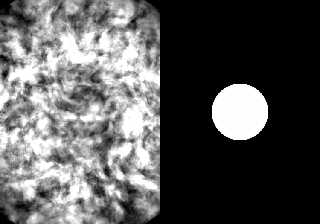|
 |
Is there any way to get Radiosity to interact with scattering Media?
In the left side of the attached image I have a point light inside a
media-filled shell and it looks the way I would expect.
On the right side I replace the light with a white sphere with ambient 1 and
turn on radiosity...in this case the light doesn't interact with the scattering
media at all.
Is there a way to do it?
Example scene below:
#version 3.6;
#include "colors.inc"
#declare use_rad = true;
global_settings {
assumed_gamma 2.2
#if(use_rad)
radiosity {
pretrace_start 0.08 // start pretrace at this size
pretrace_end 0.04 // end pretrace at this size
count 35 //50 //35 // higher -> higher quality
(1..1600) [35]
nearest_count 5 //7 //5 // higher -> higher quality (1..10)
[5]
error_bound 1.8 // higher -> smoother, less accurate [1.8]
recursion_limit 3 // how much interreflections are calculated
(1..5+) [3]
low_error_factor .5 // reduce error_bound during last pretrace
step
gray_threshold 0.0 // increase for weakening colors (0..1) [0]
minimum_reuse 0.015 // reuse of old radiosity samples [0.015]
brightness 1 //.75 //.25 //1 // brightness of radiosity
effects (0..1) [1]
adc_bailout 0.01/2
normal on // take surface normals into account [off]
media on // take media into account [off]
//save_file "file_name" // save radiosity data
//load_file "file_name" // load saved radiosity data
//always_sample off // turn sampling in final trace off [on]
//max_sample 1.0 // maximum brightness of samples
}
#end
}
// ----------------------------------------
camera {
location <0.0, 0.0, -4.0>
direction 1.0*z
right x*image_width/image_height
look_at <0.0, 0.0, 0.0>
}
difference {
sphere { <0, 0, 0>, 2.0 }
sphere { <0, 0, 0>, 1.0 }
texture {
pigment { color rgbt 1.0 }
finish { ambient 0 }
}
hollow
interior {
media {
scattering { 1, 1 extinction 0.01 }
density {
granite
density_map {
[0.45 color rgb 0]
[0.55 color rgb 1]
}
turbulence 0.5
}
samples 30, 100
}
}
}
#if(use_rad)
sphere {
<0, 0, 0>, 0.5
texture {
pigment { color rgb 1.0 }
finish { ambient 1 }
}
}
#else
light_source {
0*x // light's position (translated below)
color rgb <1,1,1> // light's color
}
#end
Post a reply to this message
Attachments:
Download 'radtest.jpg' (153 KB)
Preview of image 'radtest.jpg'

|
 |
|
 |
Am 19.07.2013 20:43, schrieb jceddy:
> Is there any way to get Radiosity to interact with scattering Media?
>
> In the left side of the attached image I have a point light inside a
> media-filled shell and it looks the way I would expect.
>
> On the right side I replace the light with a white sphere with ambient 1 and
> turn on radiosity...in this case the light doesn't interact with the scattering
> media at all.
>
> Is there a way to do it?
What you're trying to do seems to be...
> radiosity {
> pretrace_start 0.08 // start pretrace at this size
> pretrace_end 0.04 // end pretrace at this size
> count 35 //50 //35 // higher -> higher quality
> (1..1600) [35]
> nearest_count 5 //7 //5 // higher -> higher quality (1..10)
> [5]
> error_bound 1.8 // higher -> smoother, less accurate [1.8]
> recursion_limit 3 // how much interreflections are calculated
> (1..5+) [3]
> low_error_factor .5 // reduce error_bound during last pretrace
> step
> gray_threshold 0.0 // increase for weakening colors (0..1) [0]
> minimum_reuse 0.015 // reuse of old radiosity samples [0.015]
> brightness 1 //.75 //.25 //1 // brightness of radiosity
> effects (0..1) [1]
>
> adc_bailout 0.01/2
> normal on // take surface normals into account [off]
> media on // take media into account [off]
... kind of the opposite of this last statement.
"radiosity { media on }" causes light /from/ media (either scattered or
emitted) to be taken into account when computing how much light a
surface receives from sources other than traditional light sources.
If I understand you correctly, then you want POV-Ray to compute how much
light the /media/ receives from sources other than traditional light
sources.
If that is your intention, then the answer to your question is a simple
yet unsatisfactory "No". MCPov might support it (and it should, given
that it doesn't support traditional light sources at all), but I'm not
entirely sure about that.
Post a reply to this message
|
 |




![]()